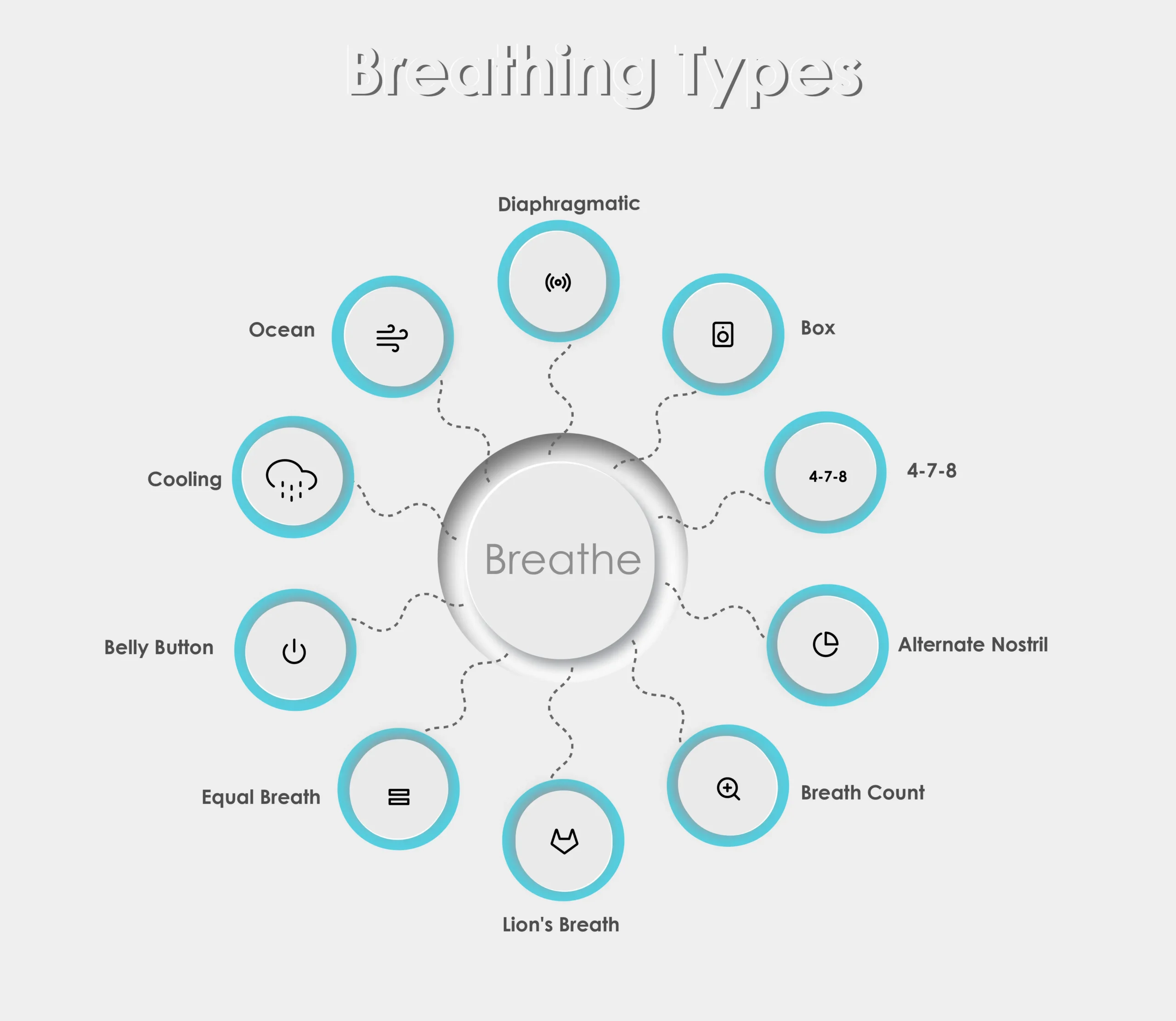Mindful breathing is a powerful and time tested mindfulness practice that can help you relax, reduce stress, and stay present in the moment. Here are the steps to practice mindful breathing:
Mindful breathing in 10 Steps
- Find a Quiet Space: Choose a quiet and comfortable place where you can sit or lie down without distractions. You can practice mindful breathing anywhere, but a quiet environment can enhance your focus.Yeah you can back support against a wall .
- Get Comfortable: Sit in a comfortable position with your back straight but not rigid. You can sit on a chair, cushion, or the floor, or lie down on your back. Place your hands on your lap or by your sides.
- Close Your Eyes (Optional): Closing your eyes can help you reduce external distractions and turn your attention inward, but it’s not necessary if you prefer to keep them open.If you feel you tend to sleep off with eyes closed – then keep them open.
- Focus on Your Breath: Start by taking a few deep breaths to settle into the practice. Then, breathe naturally and shift your attention to your breath. Pay attention to the sensation of your breath as it enters and leaves your body.
- Observe the Breath: Notice the physical sensations associated with your breath. Feel the coolness of the inhale and the warmth of the exhale. Pay attention to the rise and fall of your chest or the expansion and contraction of your abdomen.
- Counting (Optional): Some people find it helpful to count their breaths as they inhale and exhale. You can count each inhale and exhale as one cycle, and aim to count to a specific number, such as five or ten, before starting over.
- Stay Present: As you continue to breathe mindfully, your mind may start to wander. It’s natural for thoughts, distractions, or emotions to arise. When this happens, gently acknowledge the distraction without judgment and bring your focus back to your breath.
- Deepen Your Breath (Optional): If you’d like to deepen your relaxation, you can gradually make your breaths slower and deeper. Inhale deeply through your nose, allowing your abdomen to rise, and exhale slowly through your mouth.
- Set a Timer (Optional): If you have a specific amount of time for your practice, you can set a timer to signal the end of your mindful breathing session. This can help you stay committed to your practice.
- End Mindfully: When your practice time is up or when you feel ready to end, take a few deep breaths and gradually open your eyes if they were closed. Take a moment to notice how you feel after the practice.
Mindful breathing is a skill that becomes more effective with regular practice. It can be done for just a few minutes or extended to longer sessions depending on your preference and availability. As you practice mindful breathing, you’ll develop the ability to stay present, reduce stress, and cultivate a sense of calm and awareness in your daily life.
Breathe In from Nose – Breathe out from either Nose or Mouth
The process of breathing involves inhaling (breathing in) and exhaling (breathing out), and it occurs through several parts of your respiratory system, primarily in the chest and abdominal area. Here’s a simplified explanation of where breathing in and breathing out happen:
Breathing In (Inhalation):
- Nasal Cavity: When you breathe in, air enters your body through your nostrils and flows into your nasal cavity. The nasal cavity helps filter, humidify, and warm the incoming air.
- Pharynx: From the nasal cavity, the air moves into the pharynx, a passage at the back of your throat.
- Larynx: The air then passes through the larynx, commonly known as the voice box, which contains your vocal cords.
- Trachea: After passing through the larynx, the air enters the trachea, a tube-like structure that leads to the lungs. The trachea is lined with tiny hair-like structures called cilia, which help trap particles and move them out of the airway.
- Bronchial Tubes: The trachea divides into two bronchial tubes, one for each lung.
- Lungs: Finally, the air reaches your lungs, where it enters into the bronchioles and ultimately into tiny air sacs called alveoli. It’s in the alveoli that the exchange of oxygen and carbon dioxide with the bloodstream takes place.
Breathing Out (Exhalation):
The process of exhaling is essentially the reverse of inhaling:
- Lungs: After oxygen has been transferred from the air in the alveoli to your bloodstream, the air that remains in your lungs contains carbon dioxide (a waste product of cellular metabolism).
- Bronchial Tubes: The carbon dioxide-rich air travels back up the bronchial tubes.
- Trachea: It then passes through the trachea.
- Larynx: The air passes through the larynx once more.
- Pharynx: It continues through the pharynx.
- Mouth or Nose: Finally, when you exhale, the air is expelled from your body either through your mouth or nose.
The process of breathing in and out is a continuous cycle that happens thousands of times a day, allowing your body to take in oxygen and remove carbon dioxide, which is crucial for your survival and overall well-being. It’s an involuntary process controlled by the respiratory center in your brainstem, but you can also consciously control your breathing when needed, as in practices like meditation or deep breathing exercises.
